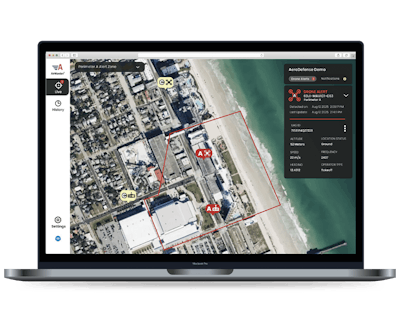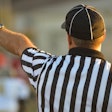
An unauthorized drone hovering over a packed stadium poses a complex challenge that extends far beyond simple trespassing. While most incidents involve harmless enthusiasts seeking aerial footage, facility operators can no longer ignore the proliferation of drones above their venues.
“We haven’t seen a lot of terrorist attacks with drones yet,” says John Sullivan, a retired Los Angeles County Sheriff’s Department lieutenant and current research fellow at Arizona State University’s Future Security Initiative, adding, “But we know that criminal groups and potential terrorist organizations are aware of the technology, and we know they can use them.”
The drone threat encompasses multiple layers of concern. Beyond the possibility of weaponization, unauthorized aircraft can disrupt events, interfere with emergency response operations, conduct surveillance for future attacks, malfunction and cause injury within the crowd or simply create panic among spectators. Athletics venues present particularly attractive targets because they combine large numbers of people with high visibility — two elements that align with terrorist objectives.
“Terrorists don’t just want a lot of people dead. They want a lot of people to see what they’ve done. Terrorism is theater,” Sullivan says. “Stadiums where there are a lot of cameras are the perfect stage.”
Aside from bad actors, even innocent operators can pose risks when their aircraft trespass over a crowd of people. The challenges have multiplied right along with the number of airborne devices.
Identification
The fundamental problem facing venue operators is distinguishing between legitimate and threatening aircraft in increasingly crowded skies. The number of drones registered with the FAA continues to grow every year, but registration doesn’t guarantee compliance or reveal intent.
“Not every drone is bad,” notes Lexi Rinaudo, chief marketing officer for AeroDefense. “But if you don’t know what’s in your airspace, it’s kind of like you don’t know what you don’t know.”
Traditional identification methods relied heavily on visual spotting, but modern drones can be difficult to see, especially at a distance or in poor air quality or lighting conditions. The challenge multiplies when considering that hostile operators can deliberately obscure their aircraft’s identity or disable identification systems.
The FAA’s Remote ID mandate, which took full effect in 2023, has created new identification opportunities. The regulation requires most drones over 0.55 pounds to broadcast digital identification information, essentially creating “a digital license plate for drones” that includes pilot location, aircraft ID and altitude data.
However, Sullivan warns that identification technology has limitations. “When they turn it off, then you just know there’s a drone, but you don’t know whose it is,” he explains. “But when they do have that capability turned on, you can absolutely know and say, ‘Okay, this is this type of drone.’ ”
Even successful identification doesn’t guarantee effective response. Current federal law severely limits mitigation options for civilian venues. Only four federal agencies have legal authority to disable or “mitigate” drones: the Department of Defense, the Department of Justice, the Department of Homeland Security and the Department of Energy.
“You have no legal authority to take down a drone,” Sullivan emphasizes. “Drones are aircraft. There are limited times when you can, if you have lawful authority, mitigate that if it's a threat."”
This creates what Sullivan calls a “legal operational lacuna”— a gap between optimal security responses and current legal frameworks. The practical solution often involves locating and approaching the pilot rather than disabling the aircraft. “Most of them are flying line of sight,” Sullivan says, “and while you can’t take it out of the air, you could go arrest the guy or simply cite the guy.”
Collaboration
The complexity of drone security demands comprehensive planning that extends well beyond purchasing detection equipment. Sullivan advocates for a systems approach that integrates multiple stakeholders and technologies.
“If you’re talking about a stadium operator, you want to get legal counsel in, and you want to get buy-in from all those different entities,” Sullivan advises. “Bring the operations people in, bring the maintenance people in. It’s not just security staff. You need to bring the vendors in. It’s an entire systems approach.”
Aside from personnel, professional-grade drone detection typically employs multiple technologies working in concert.
The detection arsenal includes visual detection through existing CCTV systems, radar systems for tracking flight patterns, electronic signature detection for Remote ID and other broadcasts, acoustic sensors for audio identification and LIDAR technology for precise positioning. Many venues already possess some of these capabilities through existing security infrastructure.
“I would start by integrating what you have,” Sullivan recommends. “You take all of those tools, you put them into one package, you don’t rely upon one thing. You do sensor fusion and triangulation. You take multiple signals, multiple sources and quickly decide: this is a threat, this is not, this is an irritant, this is a high threat.”
The cost barrier that once limited drone detection to major professional venues is rapidly decreasing. Traditional systems that started around $100,000 are being supplanted by more accessible alternatives that leverage cloud-based architectures and subscription models.
AeroDefense’s AirWarden Essentials exemplifies this shift, offering drone detection for under $5,000 annually. The system leverages Remote ID technology through strategically placed receivers that feed real-time information to web-based dashboards. “Customers get complimentary hardware, so they’re just paying for the software subscription,” Rinaudo explains.
The subscription model eliminates massive upfront hardware costs while providing features designed for real-world operations. The authorization management feature allows venues to pre-authorize friendly drones, such as media aircraft covering events, thus preventing false alarms and wasted resources. For organizations managing multiple facilities, centralized monitoring provides oversight across all locations through a unified interface.
The affordability aspect of systems like those offered by AeroDefense is expanding drone detection beyond professional sports. Rinaudo says her company has deployed systems at the University of Washington and Fresno State.
“We are seeing traffic to our site for school districts and K through 12,” Rinaudo reports. “You’ve got drones that are spying on kids, which is kind of creepy to think about, but it’s happened.”
The K-12 market faces unique challenges, balancing security concerns with budget constraints and the need to maintain an opening and welcoming environment. Rinaudo says that high school athletics programs, particularly in states such as Texas, where stadiums can rival college facilities in size and attendance, represent an emerging market for drone detection technology.
Future threat considerations
As drone technology evolves, detection systems must adapt to emerging challenges. Sullivan highlights the growing potential for drone swarms, which could overwhelm traditional response capabilities.
“You can fly drone swarms off a commercial app right off your iPhone, probably a dozen of them,” he notes. “Could swarms be AI-enhanced? Yes. That’s already a reality, even at the commercial, off-the-shelf level.”
For athletics facilities, the convergence of affordable technology, collaborative planning and operational training is creating new possibilities for comprehensive airspace security. The question is no longer whether drone detection is financially feasible, but whether organizations can afford not to implement some form of drone identification and mitigation in an era of rapidly evolving aerial threats.







































